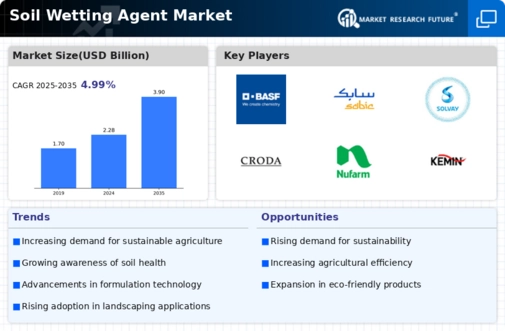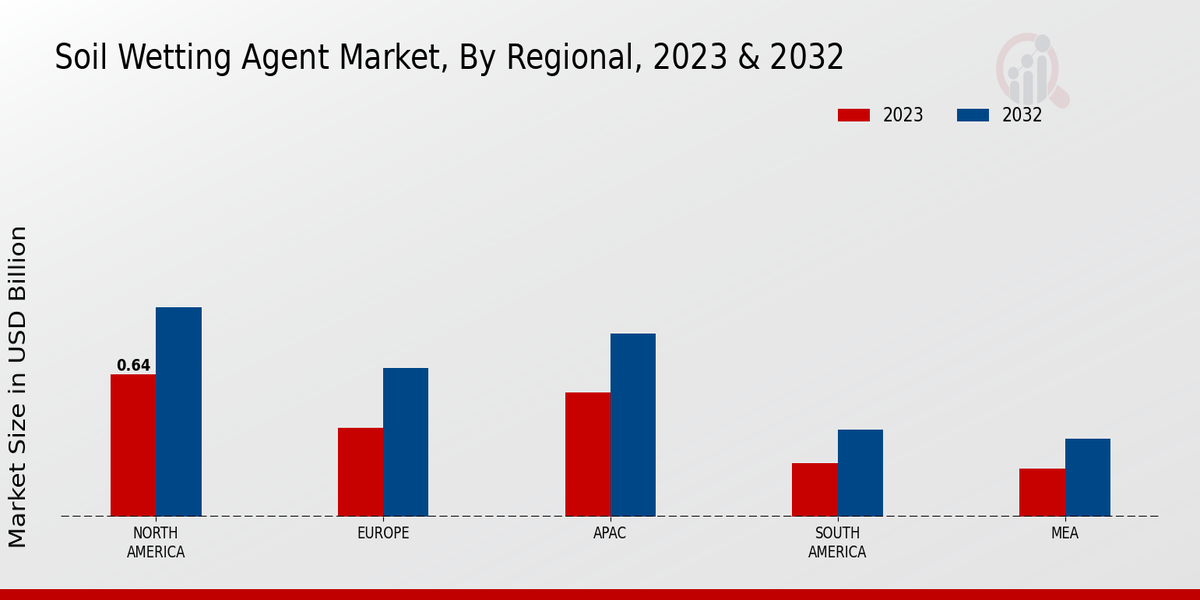Market Growth Projections
The Global Soil Wetting Agent Market Industry is poised for substantial growth, with projections indicating a market size of 2.28 USD Billion in 2024 and an anticipated increase to 3.9 USD Billion by 2035. This growth reflects a compound annual growth rate of 4.99% from 2025 to 2035. The increasing adoption of soil wetting agents across various agricultural sectors, driven by factors such as climate change, technological advancements, and government support, suggests a robust market trajectory. These figures underscore the potential for soil wetting agents to play a pivotal role in enhancing agricultural productivity and sustainability.
Increasing Agricultural Demand
The Global Soil Wetting Agent Market Industry is experiencing growth driven by the rising demand for agricultural products. As the global population continues to expand, the need for efficient water management in agriculture becomes paramount. Soil wetting agents enhance water infiltration and retention, thereby improving crop yields. In 2024, the market is projected to reach 2.28 USD Billion, reflecting the urgency for sustainable agricultural practices. This demand is likely to escalate as farmers seek solutions to combat water scarcity and optimize resource use, indicating a robust market trajectory for soil wetting agents.
Rising Awareness of Soil Health
There is a growing awareness of the importance of soil health among farmers and agricultural stakeholders, which is positively influencing the Global Soil Wetting Agent Market Industry. Healthy soils are crucial for sustainable agriculture, and soil wetting agents contribute to improving soil structure and moisture retention. As educational programs and research highlight the benefits of maintaining soil health, farmers are increasingly likely to incorporate these agents into their practices. This trend suggests a potential increase in market demand, as stakeholders recognize the long-term advantages of investing in soil health through the use of wetting agents.
Climate Change and Water Scarcity
The impact of climate change on water availability is a critical driver for the Global Soil Wetting Agent Market Industry. As regions face increasing drought conditions, the need for effective soil moisture management becomes essential. Soil wetting agents play a vital role in enhancing water retention in soils, thereby supporting crop growth in arid conditions. This necessity is expected to propel the market, with projections indicating a growth to 3.9 USD Billion by 2035. Farmers are likely to adopt these agents as a strategic response to mitigate the adverse effects of climate change on agricultural productivity.
Government Initiatives and Support
Government policies and initiatives aimed at promoting sustainable agriculture are fostering growth in the Global Soil Wetting Agent Market Industry. Various countries are implementing regulations and providing incentives for the use of environmentally friendly agricultural practices. These initiatives often include subsidies for soil wetting agents, encouraging farmers to adopt such products. As governments recognize the importance of sustainable farming in ensuring food security, the market for soil wetting agents is likely to expand. This support could lead to a compound annual growth rate of 4.99% from 2025 to 2035, reflecting a commitment to sustainable agricultural practices.
Technological Advancements in Agriculture
Technological innovations are significantly influencing the Global Soil Wetting Agent Market Industry. The development of advanced formulations and application techniques enhances the effectiveness of soil wetting agents. For instance, the introduction of biodegradable and eco-friendly products aligns with the increasing emphasis on sustainable farming practices. As farmers adopt precision agriculture technologies, the demand for soil wetting agents that integrate seamlessly with these systems is likely to rise. This trend suggests that the market could experience substantial growth, particularly as the industry moves towards more sustainable and efficient agricultural solutions.












